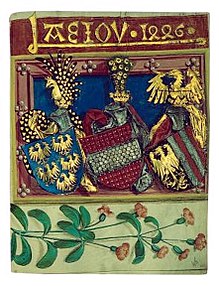Old Austria and New Austria

Old Austria and New Austria are two old heraldic names for the coat of arms of the Duchy of Austria .
History of the two terms

• New Austria with the peacock bump , here perhaps for Inner Austria Frederick III./V.
• Eagle and silver-red split, helmet crown: growing an eagle with scales in its beak, for Austria whether the Enns Albrechts VI.
above the motto AEIOV , dated 1446 (illumination in Friedrich's hand registry
)
Originally, Old Austria was the name of a five-eagle coat of arms, which under Rudolf IV. Was added in the official heraldry to the binding shield ( red-silver-red ) - the house coat of arms of the Habsburgs adopted by the Babenbergers .
From Friedrich III. Until 1918 they were part of all essential Austrian coats of arms. The designations "Old Austria" for the five-eagle coat of arms and "New Austria" for the binding shield appear in heraldic books for the first time around 1430. They were used in the heraldic sense until 1804, when the five-eagle coat of arms became the coat of arms of Austria under the Enns .
The binding shield joins the Althabsburg coat of arms , that is, the red, blue crowned, armed and bezel-tipped lion on a golden background of the county of Habsburg (in this form since 1359 under Albrecht III with the braid ), as it is also in the Habsburg-Lorraine coat of arms finds in front.
The eagles in old Austria were always gold , the shield was alternately black or blue. The number of eagles varies until the number five for the hereditary lands Austria above and below the Enns, Styria , Carinthia , Krain and Windic March , or Lower Austria , Inner Austria , Upper Austria and western Austria and the Office of the kingdom erzjägermeisters in time Rudolf IV. Of the founder naturalized (similar for example with the French lily, the fleur-de-lys , the number of which fluctuates with the respective territories and goes as far as the sown field, and was only set at three by Charles IV in the 1320s ).
This interpretation solidified when the old Habsburg ancestral lands ( Habsburg , Kyburg and others) were lost to the Swiss Confederation in the 14th and 15th centuries . In the Habsburg inheritance divisions , the areas for which the five eagles stood - despite the different house contract of Rudolf the founder ( Rudolfinische Hausordnung 1364) - came into separate hands for a time. Only under Maximilian I. - Friedrichs III. Son - what was then Austria was placed under the common crown again after 1490.
At the end of the 15th century, some historiographers interpreted the five-eagle coat of arms as the " lark coat of arms ". This name is occasionally still in use today.
The coats of arms of New and Old Austria remained the coats of arms of the House of Austria until 1804 - this is how the binding shield is called in modern times the "coat of arms House of Austria" - and of the land under the Enns. Since 1804 the five eagles were the coat of arms of the Archduchy of Austria under the Enns (Lower Austria). The other part of the actual Duchy of Austria, namely Austria ob der Enns (Upper Austria), had its own coat of arms since the beginning of modern times (golden eagle split in black and silver-red), and at that time it was already an independent crown land and then also an archduchy .
Until 1918 the shield of Lower Austria was crowned with the Archduke's hat. Today the five-eagle coat of arms - on a blue background - stands for the federal state of Lower Austria , the binding shield is placed as a breast shield on the federal eagle , Austria's national coat of arms.
In terms of cultural history, the expression “ Altösterreich” became gradually associated with the Austrian Empire after 1804/06, 1867 and 1918 . the Austro-Hungarian Dual Monarchy , its part of the empire Cisleithanien , or the German-Austrian territories.
Contemporary illustrations
Alt Osterri / ch hergest // Nu Osterrich / Hertzug ; Duke Albrecht VI. in Ingeram Codex 1459
Adalbert the Victorious (around 985–1055) in the fight against the Magyars , coat of arms and standard , Babenberger family tree , around 1490
Leopold the Saint (1095–1136) in front of Klosterneuburg in eagle regalia , Babenberger family tree, around 1490
Habsburg peacock with the two coats of arms, Augsburg 1555
See also
- Coat of arms of Hungary , for the similar terms Old and New Hungary
Individual evidence
- ↑ Entry on Bindenschild in the Austria Forum (in the AEIOU Austria Lexicon )
- ↑ a b c d e Gall, pp. 124-125.
- ↑ Otto Posse: The seals of the German emperors and kings . tape 5 . Wilhelm and Bertha v. Baensch Foundation, Dresden 1913, supplements, p. 252 ( Wikisource - author's note on the new title and coat of arms of His Roman and Austrian Imperial and Royal Apostolic Majesty, after the changes brought about by the Luneviller Peace Treaty and the Supreme Pragmatical Ordinance of August 8th, 1804. Vienna, 1804 ).
- ↑ See Scheuch: Habsburgs Stammlande, wars with the Confederates , p. 44f and Habsburgs partitions , p. 50f
literature
- Otto Posse: The seals of the German emperors and kings. Wilhelm and Bertha v. Baensch Foundation, Dresden 1913 ( full text - Wikisource)
- Peter Diem: The symbols of Austria. Time and history in signs. K&S Vienna 1995, ISBN 3-218-00594-9 (Web excerpt: The symbols of Austria )
- Franz Gall : Austrian heraldry. Handbook of coat of arms science. 3. Edition. Böhlau, Vienna / Cologne / Weimar 1996





